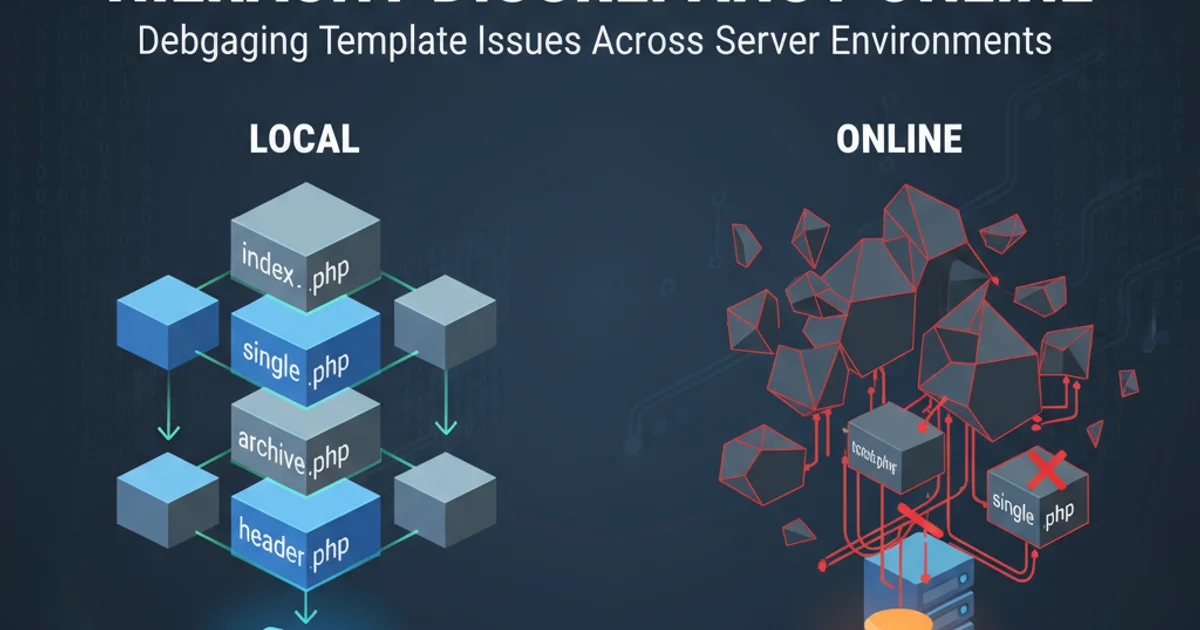Wordpress theme not following same template hierarchy when online
Categories:
Troubleshooting WordPress Theme Hierarchy Discrepancies Online

Understand why your WordPress theme might behave differently on a live server compared to your local environment, and learn how to diagnose and resolve template hierarchy issues.
Developing a WordPress theme locally is often a smooth process, but encountering unexpected behavior when deploying it to a live server can be frustrating. One common issue is when your theme doesn't seem to follow the same template hierarchy online as it did offline. This article will guide you through the common causes of such discrepancies and provide actionable steps to diagnose and fix them, ensuring your theme functions consistently across all environments.
Understanding the WordPress Template Hierarchy
The WordPress template hierarchy is a predefined set of rules that WordPress uses to determine which template file to load for a given page. When a user requests a page, WordPress searches for template files in a specific order, starting with the most specific and falling back to more general templates. For example, for a single post, WordPress might look for single-post-type.php, then single.php, and finally index.php. Understanding this order is crucial for effective theme development and debugging.
flowchart TD
A[User Request] --> B{Is it a single post?}
B -->|Yes| C{Does single-post-type.php exist?}
C -->|Yes| D[Load single-post-type.php]
C -->|No| E{Does single.php exist?}
E -->|Yes| F[Load single.php]
E -->|No| G[Load index.php]
B -->|No| H{Is it a page?}
H -->|Yes| I{Does page-slug.php exist?}
I -->|Yes| J[Load page-slug.php]
I -->|No| K{Does page-ID.php exist?}
K -->|Yes| L[Load page-ID.php]
K -->|No| M{Does page.php exist?}
M -->|Yes| N[Load page.php]
M -->|No| G
H -->|No| O[Other content type]
O --> GSimplified WordPress Template Hierarchy Flow
Common Causes of Online Template Hierarchy Issues
Several factors can lead to your theme behaving differently online. These often boil down to environmental differences or overlooked details during deployment. Identifying the root cause is the first step towards a solution.
WP_DEBUG) on your staging or development server to catch errors and warnings that might indicate template issues. Remember to disable it on production.Diagnosing and Resolving Discrepancies
Once you suspect a template hierarchy issue, a systematic approach to diagnosis is key. Here are the most common areas to investigate and how to resolve them.
1. Check File and Folder Case Sensitivity
Linux-based servers (common for hosting) are case-sensitive, unlike Windows or macOS (which you might use for local development). A file named Page.php will not be recognized if WordPress expects page.php. Ensure all your template filenames and folder names match the WordPress naming conventions exactly, including case.
2. Verify File Permissions
Incorrect file permissions can prevent the web server from reading your theme files. Typically, WordPress files should have 644 permissions and directories 755. You can usually adjust these via your hosting control panel's file manager or via SSH using chmod.
3. Clear Caches (Server, Plugin, Browser)
Caching is a frequent culprit. Your hosting provider might have server-level caching, you might be using a caching plugin (like WP Super Cache or W3 Total Cache), or your browser might be serving an old version. Clear all levels of cache after making changes to ensure you're seeing the most up-to-date version of your site.
4. Inspect Permalink Structure
Sometimes, a different permalink structure on the live site can affect how WordPress resolves URLs and, consequently, which templates it tries to load. Go to Settings > Permalinks in your WordPress admin and ensure the structure is as expected. Sometimes simply re-saving the permalinks can resolve issues related to .htaccess regeneration.
5. Use template_include Filter for Debugging
For advanced debugging, you can use the template_include filter in your theme's functions.php file to log which template file WordPress is actually loading. This provides definitive proof of the template being used.
<?php
// Add this to your theme's functions.php for debugging
add_filter( 'template_include', 'var_dump_template_path', 1000 );
function var_dump_template_path( $template ) {
error_log( 'Loading template: ' . basename( $template ) );
return $template;
}
?>
Debugging template path using template_include filter
template_include filter before deploying to a production environment, as it can expose sensitive information or impact performance.Advanced Debugging: Plugin Conflicts and Theme Updates
If the basic checks don't resolve the issue, consider potential conflicts or recent changes. A newly installed or updated plugin might interfere with the template loading process, or a recent theme update could have introduced a bug or changed expected file names.
1. Deactivate Plugins
Temporarily deactivate all plugins on your live site (or a staging copy) and check if the template hierarchy issue resolves. If it does, reactivate them one by one to identify the conflicting plugin.
2. Switch to a Default Theme
Switch your live site to a default WordPress theme (like Twenty Twenty-Four). If the issue disappears, it confirms the problem lies within your custom theme. This helps narrow down the scope of your investigation.
3. Review Theme Update Logs
If the issue appeared after a theme update, review the theme's changelog for any breaking changes or modifications to template file naming conventions.